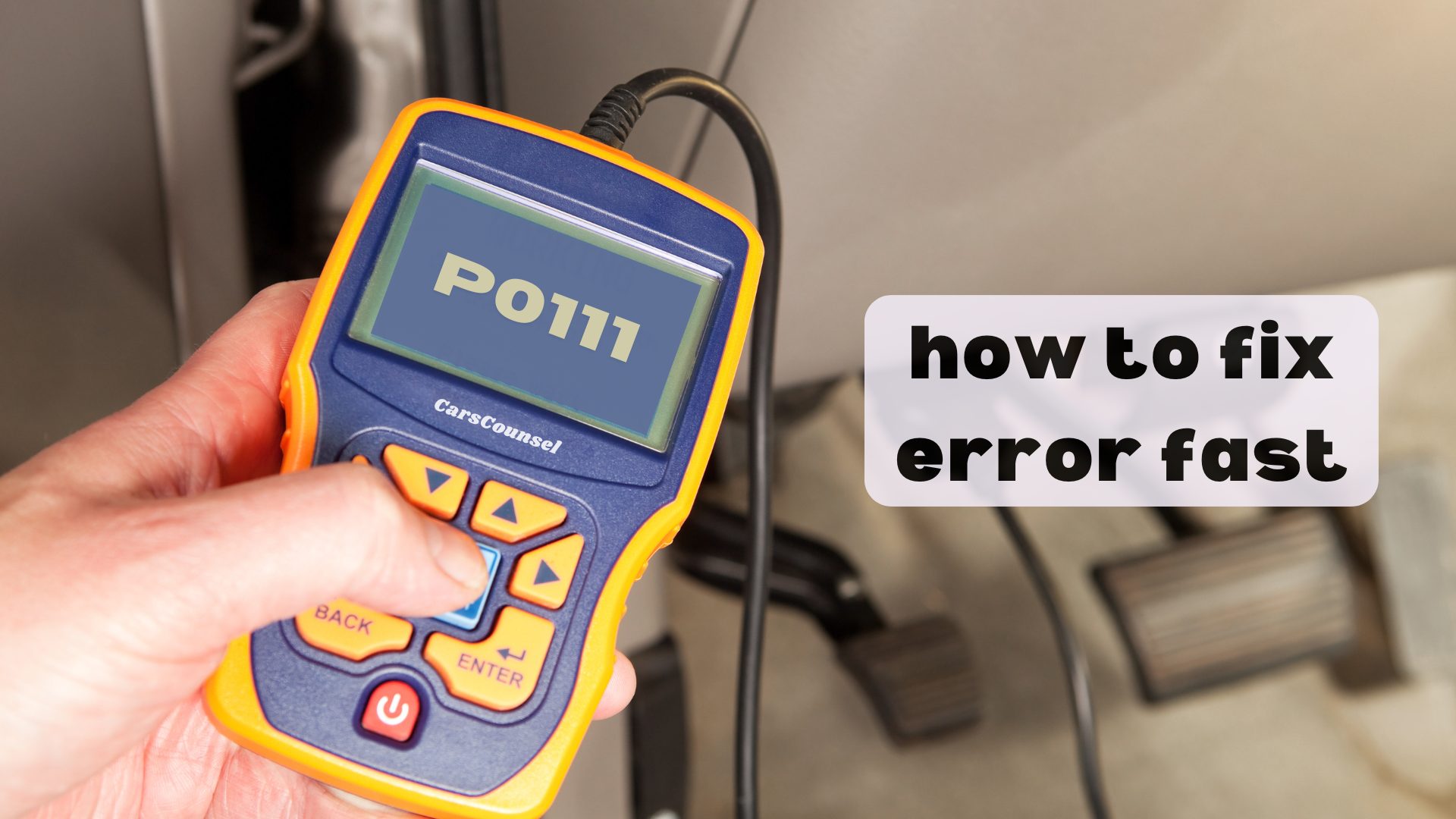You might be surprised to learn that a small, often overlooked sensor can significantly impact your engine’s performance. The Intake Air Temperature (IAT) sensor, which measures the temperature of incoming air, plays a critical role in adjusting the air-fuel mixture ratio, ignition timing, and other engine parameters.
But when it malfunctions, you’ll experience decreased fuel efficiency, rough idling, and engine hesitation—all symptoms of the P0111 code. What’s causing this performance problem, and how can you fix it? The answer lies in understanding the intricacies of the IAT sensor circuit and its potential pitfalls.

Quick Navigation
Key Takeaways
- The P0111 code indicates a problem with the Intake Air Temperature (IAT) sensor circuit, which can affect engine performance and fuel efficiency.
- A faulty IAT sensor can cause decreased fuel efficiency, rough idling, and engine hesitation, as well as trigger the Check Engine Light.
- The P0111 code is commonly caused by a faulty IAT sensor, wiring or connector issues, air leaks, and ECM software or hardware problems.
- To diagnose the issue, inspect the IAT sensor, wiring, and connectors and use a scan tool to check for air leaks and ECM problems.
- Repairing the issue may involve replacing the IAT sensor, cleaning the sensor, or fixing wiring and connector issues. Total repair costs range from $150 to $400 or more.
Code P0111 Definition
When your vehicle’s onboard computer, the Engine Control Module (ECM), detects a problem with the Intake Air Temperature (IAT) sensor circuit, it triggers the P0111 code.
This fault code indicates a range or performance problem with the IAT sensor, which measures the temperature of the incoming air into the engine.
The ECM uses this data to adjust the air-fuel mixture ratio, ignition timing, and other engine parameters to guarantee peak engine performance and fuel efficiency.
A faulty IAT sensor can lead to decreased fuel efficiency, rough idling, and engine hesitation.
Make sure to check your air filter regularly, as a dirty filter can also affect engine performance.
Causes of the P0111 Code
Faulty engine components can trigger the P0111 code, but what specific issues are behind this error?
When you encounter this code, it’s essential to identify the root cause to make the necessary repairs.
- Faulty IAT sensor: Sensor Failure can lead to inaccurate temperature readings, causing the P0111 code to trigger.
- Wiring or connector issues in the IAT sensor circuit: Wiring Issues, such as corrosion or damage, can disrupt the signal between the IAT sensor and the Engine Control Module (ECM).
- Air leaks near the IAT sensor: Leaks can affect the accuracy of the temperature readings, leading to the P0111 code.
- Dirty or contaminated sensor: A dirty or contaminated IAT sensor can provide false readings, resulting in the P0111 code.
- ECM software or hardware issues: In some cases, problems with the ECM can cause the P0111 code to trigger.
Symptoms of a Faulty IAT Sensor
Identifying the symptoms of a faulty IAT sensor is vital in diagnosing the P0111 code. As you experience issues with your vehicle, it’s essential to recognize the signs of a malfunctioning IAT sensor. You may notice decreased fuel efficiency, rough idling or stalling, and engine hesitation during acceleration. In cold weather, these symptoms can be more pronounced. Additionally, you might see inaccurate temperature readings on your dashboard or an illuminated Check Engine Light.
| Symptoms | Description |
|---|---|
| Decreased Fuel Efficiency | Lower gas mileage than usual |
| Rough Idling/Stalling | Engine struggles to maintain a smooth idle or stalls frequently |
| Engine Hesitation | Delayed or hesitant acceleration |
If you’re experiencing these symptoms, it’s possible that your IAT sensor needs cleaning or replacement. Sensor cleaning can be a simple and effective solution, but if the issue persists, further diagnostics may be necessary.
Diagnosing the P0111 Code Issue
To accurately diagnose the P0111 code issue, you’ll need to follow a structured approach that eliminates potential causes one by one.
This methodical approach will help you identify the root cause of the problem, whether it’s a faulty IAT sensor, wiring or connector issues, or ECM software or hardware problems.
- Perform a scan tool analysis to determine if the IAT sensor is reading temperatures accurately and if the sensor calibration is correct.
- Inspect the wiring and connectors for any signs of damage or corrosion.
- Check for air leaks near the IAT sensor that could be affecting its readings.
- Verify that the IAT sensor is clean and free of contaminants.
- Review the vehicle’s service history to see if any recent repairs or maintenance may have triggered the P0111 code.
Repairing the Intake Air Temperature Sensor
When dealing with a faulty IAT sensor, replacing it‘s often the most straightforward solution.
However, before replacing the sensor, you should try cleaning it to remove any dirt or debris that may be affecting its performance. Sensor cleaning can be a simple and cost-effective way to resolve the issue.
Use a soft-bristled brush and a mild detergent to gently remove any contaminants. If cleaning doesn’t work, sensor replacement is the next step.
Make sure to purchase a replacement sensor that matches the specifications of your vehicle’s original sensor. Follow the manufacturer’s instructions for installation, and guarantee all connections are secure to avoid any wiring or connector issues.
Clearing the P0111 Code Error
After diagnosing and repairing the issue causing the P0111 code, you’ll need to clear the code error to turn off the Check Engine Light and verify the engine control module (ECM) is no longer referencing the faulty data.
To clear the P0111 code error, follow these steps:
- Use a scan tool to connect to the vehicle’s onboard computer and access the trouble code menu
- Select the “Clear Codes” or “Erase Codes” option to delete the P0111 code
- Turn the ignition off and then back on to guarantee the ECM has reset
- Take the vehicle for a test drive to verify the issue has been resolved and the code doesn’t return
- Refer to Scan Tool Tips and Ignition Insights for specific guidance on clearing the code error using your particular scan tool
Associated Repair Costs and Labor
Your repair bill for the P0111 code will depend on several factors, including the shop’s labor rates, the cost of replacement parts, and the time required to diagnose and fix the issue.
Shop estimates will vary, but you can expect to pay between $50 to $150 for diagnostic fees, depending on the complexity of the problem.
If the IAT sensor needs replacement, the part itself can cost between $50 to $100, with additional labor costs ranging from $50 to $150.
Overall, your total repair bill may range from $150 to $400 or more, depending on the specifics of your situation.
Be sure to ask your mechanic for a detailed breakdown of the costs involved to get a clearer picture of what you’ll be paying.
Additional Diagnostic Tips
To further diagnose the P0111 code, you’ll want to take a closer look at the IAT sensor’s electrical circuit.
This involves checking the sensor’s voltage supply, ground connections, and signal output to guarantee they’re within the recommended specifications.
Additionally, you should:
- Verify the IAT sensor’s calibration using a scan tool or multimeter to certify it’s providing accurate temperature readings.
- Perform IAT troubleshooting by simulating different temperature conditions to see if the sensor responds correctly.
- Check for any air leaks or restrictions near the IAT sensor that could affect its readings.
- Inspect the sensor’s connector and wiring for signs of damage, corrosion, or wear.
- Consult factory service manuals or repair databases for specific diagnostic procedures and troubleshooting guides for your particular vehicle.
More OBD-II Codes
Frequently Asked Questions
Can a Faulty IAT Sensor Cause Engine Damage if Left Unrepaired?
If you don’t address a faulty IAT sensor, you risk engine damage from sensor failure, which can lead to engine overheating, potentially causing costly repairs or even engine failure, emphasizing the importance of prompt repair.
Will a P0111 Code Trigger a Failed Emissions Test?
You’ll be surprised to know that nearly 20% of vehicles on the road today fail their emissions test due to faulty sensors. When you have a P0111 code, it’s likely to trigger a failed emissions test, as the incorrect air-fuel mixture can significantly impact emissions, and test requirements are strict.
Can I Drive My Vehicle Safely With a P0111 Code?
You can drive your vehicle with a P0111 code, but beware of decreased fuel efficiency, rough idling, and hesitation during acceleration, which may impact your driving habits and overall vehicle performance, potentially leading to further damage.
Will Replacing the Air Filter Fix a P0111 Code Issue?
As you breathe new life into your engine, replacing the air filter can be a refreshing start, but it won’t directly fix a P0111 code issue; however, a high-quality filter can improve air filter quality, increase airflow, and augment filter replacement benefits, which might indirectly alleviate some symptoms.
Is It Possible to Repair a P0111 Code Without a Scan Tool?
You can try to repair the issue without a scan tool, but it’ll be challenging; in cold weather, inaccurate sensor calibration may cause issues, so you’ll need to rule out other causes, inspect wiring and connectors, and potentially clean or replace the sensor.
Conclusion
You’ve finally diagnosed and repaired the P0111 code issue, and your engine’s running smoothly again. For instance, a 2015 Honda Civic owner in California noticed a 10% decrease in fuel efficiency and rough idling after driving through a dusty desert road. After inspecting and cleaning the IAT sensor, the P0111 code was cleared, and the engine performance returned to normal. Remember to regularly check your air filter and IAT sensor to prevent similar issues and guarantee peak engine performance.

